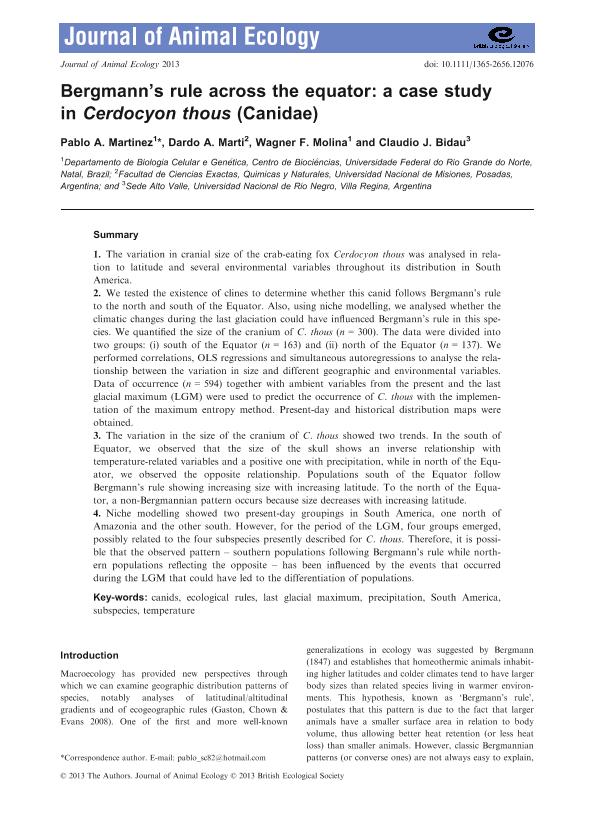Mostrar el registro sencillo del ítem
dc.contributor.author
Martinez, Pablo A.
dc.contributor.author
Marti, Dardo Andrea

dc.contributor.author
Molina, Wagner F.
dc.contributor.author
Bidau, Claudio Juan

dc.date.available
2017-11-30T17:19:52Z
dc.date.issued
2013-04
dc.identifier.citation
Martinez, Pablo A.; Marti, Dardo Andrea; Molina, Wagner F.; Bidau, Claudio Juan; Bergmann's rule across the equator: a case study in Cerdocyon thous (Canidae); Wiley; Journal Of Animal Ecology; 82; 5; 4-2013; 997-1008
dc.identifier.issn
0021-8790
dc.identifier.uri
http://hdl.handle.net/11336/29343
dc.description.abstract
1. The variation in cranial size of the crab-eating fox Cerdocyon thous was analysed in relation to latitude and several environmental variables throughout its distribution in South America. 2. We tested the existence of clines to determine whether this canid follows Bergmann’s rule to the north and south of the Equator. Also, using niche modelling, we analysed whether the climatic changes during the last glaciation could have influenced Bergmann’s rule in this species. We quantified the size of the cranium of C. thous (n = 300). The data were divided into two groups: (i) south of the Equator (n = 163) and (ii) north of the Equator (n = 137). We performed correlations, OLS regressions and simultaneous autoregressions to analyse the relationship between the variation in size and different geographic and environmental variables. Data of occurrence (n = 594) together with ambient variables from the present and the last glacial maximum (LGM) were used to predict the occurrence of C. thous with the implementation of the maximum entropy method. Present-day and historical distribution maps were obtained. 3. The variation in the size of the cranium of C. thous showed two trends. In the south of Equator, we observed that the size of the skull shows an inverse relationship with temperature-related variables and a positive one with precipitation, while in north of the Equator, we observed the opposite relationship. Populations south of the Equator follow Bergmann’s rule showing increasing size with increasing latitude. To the north of the Equator, a non-Bergmannian pattern occurs because size decreases with increasing latitude. 4. Niche modelling showed two present-day groupings in South America, one north of Amazonia and the other south. However, for the period of the LGM, four groups emerged, possibly related to the four subspecies presently described for C. thous. Therefore, it is possible that the observed pattern – southern populations following Bergmann’s rule while northern populations reflecting the opposite – has been influenced by the events that occurred during the LGM that could have led to the differentiation of populations.
dc.format
application/pdf
dc.language.iso
eng
dc.publisher
Wiley

dc.rights
info:eu-repo/semantics/openAccess
dc.rights.uri
https://creativecommons.org/licenses/by-nc-sa/2.5/ar/
dc.subject
Canids
dc.subject
Ecological Rules
dc.subject
Last Glacial Maximum
dc.subject
Precipitation
dc.subject
South America
dc.subject
Subspecies
dc.subject
Temperature
dc.subject.classification
Otras Ciencias Biológicas

dc.subject.classification
Ciencias Biológicas

dc.subject.classification
CIENCIAS NATURALES Y EXACTAS

dc.title
Bergmann's rule across the equator: a case study in Cerdocyon thous (Canidae)
dc.type
info:eu-repo/semantics/article
dc.type
info:ar-repo/semantics/artículo
dc.type
info:eu-repo/semantics/publishedVersion
dc.date.updated
2016-12-26T18:45:21Z
dc.journal.volume
82
dc.journal.number
5
dc.journal.pagination
997-1008
dc.journal.pais
Estados Unidos

dc.journal.ciudad
Hoboken
dc.description.fil
Fil: Martinez, Pablo A.. Universidade Federal do Rio Grande do Norte; Brasil
dc.description.fil
Fil: Marti, Dardo Andrea. Universidad Nacional de Misiones. Facultad de Ciencias Exactas, Químicas y Naturales; Argentina. Consejo Nacional de Investigaciones Científicas y Técnicas; Argentina
dc.description.fil
Fil: Molina, Wagner F.. Universidade Federal do Rio Grande do Norte; Brasil
dc.description.fil
Fil: Bidau, Claudio Juan. Universidad Nacional de Rio Negro. Sede Alto Valle; Argentina. Consejo Nacional de Investigaciones Científicas y Técnicas; Argentina
dc.journal.title
Journal Of Animal Ecology

dc.relation.alternativeid
info:eu-repo/semantics/altIdentifier/doi/http://dx.doi.org/10.1111/1365-2656.12076
dc.relation.alternativeid
info:eu-repo/semantics/altIdentifier/url/http://onlinelibrary.wiley.com/doi/10.1111/1365-2656.12076/abstract
Archivos asociados
